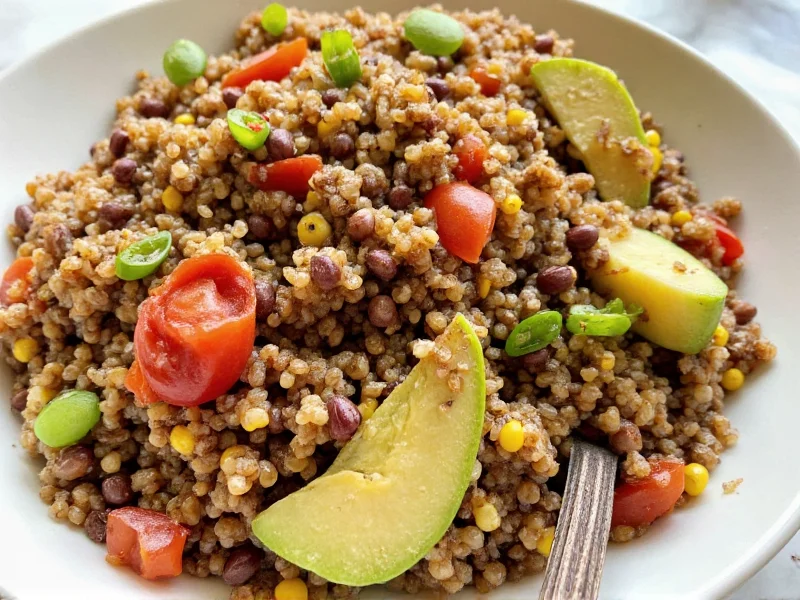When exploring quinoa and lentils nutritional comparison, both stand out as superfoods with complementary benefits. These ancient ingredients have sustained civilizations for millennia and continue gaining popularity among health-conscious eaters, vegetarians, and athletes seeking plant-powered nutrition.
Nutritional Profile Comparison
Understanding the differences between quinoa and lentils starts with examining their nutritional composition. While both provide substantial protein, their micronutrient profiles vary significantly, making them excellent complements rather than substitutes.
| Nutrient (per 100g cooked) | Quinoa | Lentils |
|---|---|---|
| Calories | 120 | 116 |
| Protein | 4.4g | 9g |
| Fiber | 2.8g | 7.9g |
| Iron | 1.49mg (8% DV) | 3.3mg (18% DV) |
| Folate | 42mcg (11% DV) | 181mcg (45% DV) |
| Magnesium | 64mg (15% DV) | 36mg (9% DV) |
| Complete Protein | Yes | No |
Health Benefits of Quinoa and Lentils
The health benefits of quinoa versus lentils reveal why nutritionists recommend incorporating both into regular meal planning. Their synergistic effects create a nutritional powerhouse that exceeds what either provides alone.
Quinoa Advantages
- Complete protein source - Contains all nine essential amino acids, rare among plant foods
- Gluten-free - Safe for celiac disease and gluten sensitivity
- Rapid cooking time - Ready in 15-20 minutes compared to hours for many grains
- Rich in flavonoids - Contains quercetin and kaempferol with anti-inflammatory properties
Lentils Advantages
- Exceptional fiber content - Supports gut health and stable blood sugar
- High iron bioavailability - Especially valuable for vegetarians and women of childbearing age
- Low glycemic index - Helps manage diabetes and prevent insulin resistance
- Economical protein source - More affordable than many meat alternatives
How Quinoa and Lentils Complement Each Other
When considering cooking quinoa with lentils, their complementary amino acid profiles create complete protein. Quinoa provides methionine and cysteine that lentils lack, while lentils supply lysine that quinoa has in lower amounts. This makes them ideal partners in vegetarian and vegan meal planning.
Professional chefs and nutritionists often combine these ingredients in dishes like:
- Protein-packed salads with roasted vegetables
- Hearty vegetarian burgers and meatless loaves
- Nutrient-dense soups and stews
- Buddha bowls with complementary vegetables and sauces
Practical Cooking Guide
Mastering how to cook quinoa and lentils together requires understanding their different preparation needs. While both benefit from rinsing before cooking, their water ratios and cooking times differ significantly.
Quinoa Preparation
- Rinse thoroughly to remove saponins (natural coating that can taste bitter)
- Use 1.75 cups water per cup of quinoa
- Bring to boil, then simmer covered for 15 minutes
- Let stand 5 minutes, then fluff with fork
Lentil Preparation
- Sort and rinse to remove debris
- Use 2.5 cups water per cup of lentils
- Simmer uncovered 20-25 minutes for green/brown lentils
- Red lentils cook faster (15-20 minutes) and become creamy
For quinoa and lentils recipe ideas, try cooking them separately then combining in finished dishes. This prevents overcooking one ingredient while waiting for the other to finish. The classic Middle Eastern mujadara combines lentils with caramelized onions and rice, but substituting quinoa creates an even more nutrient-dense version.
Storage and Shelf Life
Proper storage maximizes the quinoa and lentils shelf life and maintains nutritional value:
- Dry storage: Keep in airtight containers in cool, dark place (up to 2 years)
- Cooked storage: Refrigerate for 5-7 days or freeze up to 6 months
- Pre-rinsing tip: Rinse quinoa just before use to prevent premature spoilage
- Freezing cooked lentils: Portion into ice cube trays for easy recipe additions
When planning meals with quinoa lentils protein content in mind, remember that cooked portions provide about 8-9g of protein per cup, making them excellent foundations for post-workout meals or satisfying lunches.
Special Dietary Considerations
Both ingredients excel in specialized diets:
- Gluten-free diets: Naturally gluten-free (ensure certified if celiac)
- Vegan nutrition: Provides complete protein when combined
- Diabetes management: Low glycemic index supports blood sugar control
- Heart health: Soluble fiber reduces LDL cholesterol
For those exploring quinoa and lentils for weight loss, their high fiber and protein content promotes satiety while delivering substantial nutrition per calorie. A single cup of cooked quinoa and lentils mixture provides approximately 220 calories with 13g protein and 10g fiber.











 浙公网安备
33010002000092号
浙公网安备
33010002000092号 浙B2-20120091-4
浙B2-20120091-4